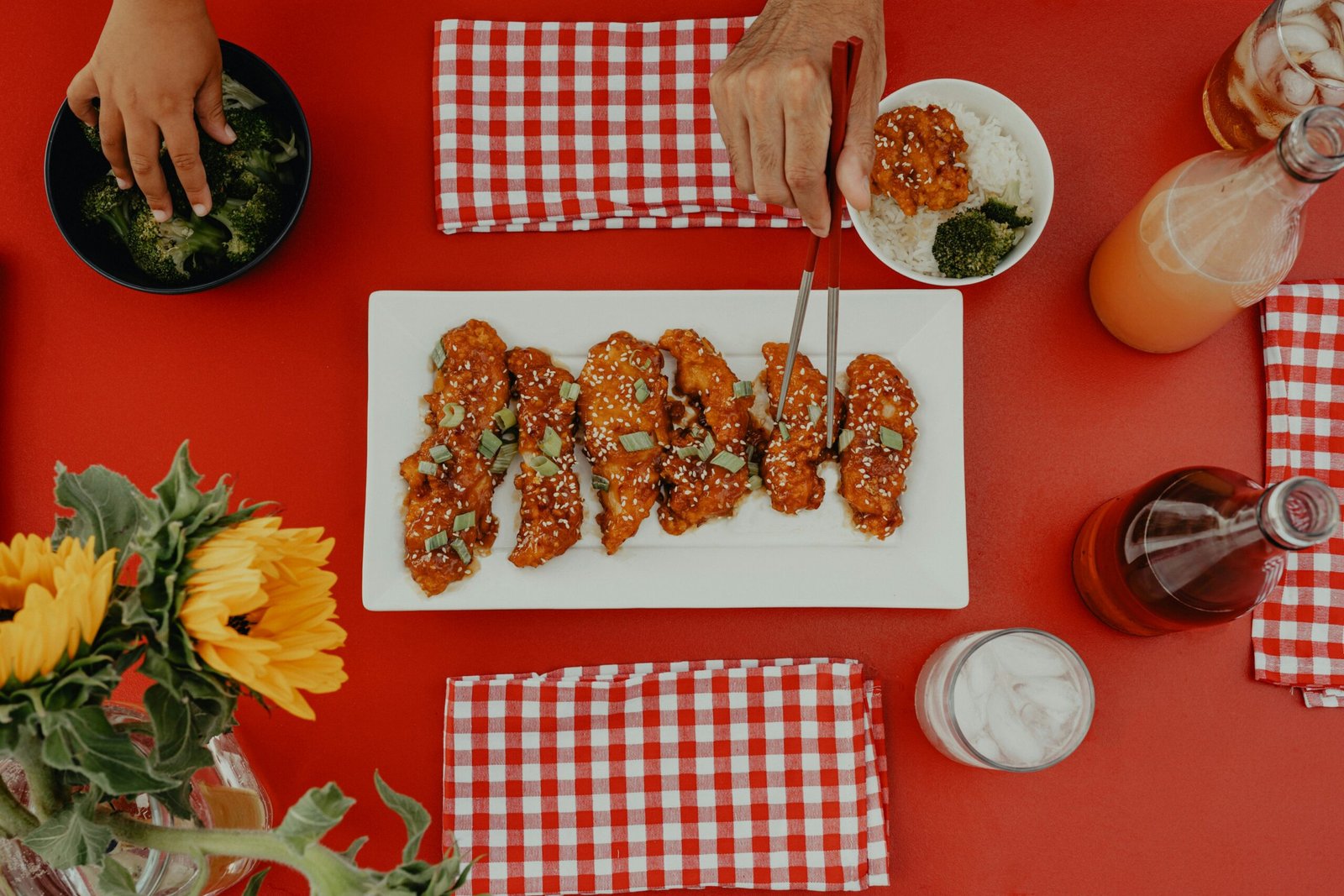
How to Make Crispy Fried Chicken: A Complete Recipe
Introduction to Crispy Fried Chicken
Crispy fried chicken stands as a culinary icon, cherished for its irresistible combination of a crunchy, golden-brown exterior and tender, juicy meat inside. This beloved comfort food transcends cultural boundaries, capturing the hearts and taste buds of people around the globe. The magic lies in achieving the perfect balance between the crispy crust that shatters with each bite and the succulent chicken that follows, creating a symphony of textures and flavors that is hard to resist.
One of the many reasons crispy fried chicken is so adored is its remarkable versatility. It seamlessly fits into a variety of dining scenarios, from casual family dinners to festive outdoor picnics. Whether served hot and fresh from the fryer or cold and packed in a picnic basket, fried chicken maintains its delicious charm. Its adaptability also extends to the countless variations in seasoning and preparation methods, allowing cooks to infuse their unique touch into this classic dish.
In this blog post, readers will embark on a culinary journey to master the art of making crispy fried chicken. We will guide you through each step of the process, from selecting the right cut of chicken to achieving that coveted crunch. Along the way, we will share tips and techniques that ensure your fried chicken turns out perfectly every time. Prepare to elevate your cooking skills and delight your family and friends with homemade crispy fried chicken that rivals any restaurant offering.
Ingredients Needed
To achieve the perfect crispy fried chicken, using fresh, high-quality ingredients is paramount. The following list outlines the essential components for this recipe, ensuring a delicious and crunchy outcome:
Chicken Pieces: Select an assortment of chicken parts such as drumsticks, thighs, and wings. These pieces are ideal for frying due to their size and meat-to-bone ratio.
Flour: All-purpose flour is a staple ingredient, providing the necessary coating that crisps up beautifully when fried.
Cornstarch: Adding cornstarch to the flour mixture enhances the crunchiness of the chicken’s exterior, creating a light and airy crust.
Buttermilk: Buttermilk acts as a tenderizing agent. Marinating the chicken in buttermilk ensures the meat remains juicy and flavorful.
Eggs: Eggs are used to create a binding layer between the chicken and the flour mixture, aiding in the adhesion of the coating.
Baking Powder: Incorporating a small amount of baking powder into the flour mixture helps achieve an extra crispy texture.
Salt and Pepper: Essential seasonings, salt and pepper enhance the overall flavor of the chicken, ensuring a well-balanced taste.
Paprika: Paprika adds a subtle smokiness and a vibrant color to the coating, contributing to both flavor and visual appeal.
Garlic Powder: Garlic powder infuses the chicken with a rich, savory taste that complements the other spices.
Onion Powder: Onion powder offers a sweet and tangy flavor, adding depth to the seasoning blend.
Other spices and herbs such as cayenne pepper for heat, dried thyme for earthiness, or rosemary for fragrance can also be used to customize the flavor profile to your liking. Utilizing these fresh, high-quality ingredients ensures the best possible outcome, resulting in irresistibly crispy fried chicken.
Preparing the Chicken
Proper preparation is crucial to achieving the perfect batch of crispy fried chicken. The process begins with thoroughly cleaning the chicken. Rinse each piece under cold water and pat them dry with paper towels to remove any excess moisture. If you bought a whole chicken, you will need to cut it into appropriate pieces. Typically, a whole chicken is divided into two drumsticks, two thighs, two wings, and two breasts. The breasts can be further halved to create smaller, more manageable portions.
Once the chicken is cleaned and cut, marinating is the next critical step. Marinating the chicken in buttermilk or a seasoned brine is highly recommended for enhancing both flavor and tenderness. Buttermilk is particularly effective as it contains acids and enzymes that break down proteins in the chicken, resulting in a more tender texture. Additionally, buttermilk adds a subtle tanginess that complements the savory flavors of the fried chicken.
To prepare a simple buttermilk marinade, combine buttermilk with a blend of your favorite seasonings. Common choices include salt, pepper, garlic powder, onion powder, and paprika. Submerge the chicken pieces in the marinade, ensuring each piece is fully coated. Cover the container and refrigerate for several hours or, ideally, overnight. The longer you marinate, the more flavorful and tender the chicken will be.
If you prefer a seasoned brine, dissolve salt and sugar in water and add spices like black peppercorns, bay leaves, and thyme. Immerse the chicken in the brine, cover, and refrigerate for several hours or overnight. This method infuses the chicken with a savory depth that will elevate your fried chicken to a new level.
For optimal results, ensure that every step in the marinating process is meticulously followed. Properly marinated chicken not only retains more moisture during frying but also delivers a richer flavor profile. This foundational step sets the stage for achieving the ultimate crispy fried chicken that is juicy on the inside and perfectly crispy on the outside.
Making the Coating
Creating the perfect coating mixture is a crucial step in making crispy fried chicken. Begin by preparing the dry ingredients in one bowl. Combine flour, cornstarch, and baking powder as the base. The addition of cornstarch is essential as it contributes to the crispiness of the coating, while baking powder helps to create a light, airy texture. This combination ensures the chicken has the ideal crisp exterior.
Seasoning the flour mixture adequately is key to flavorful fried chicken. Common seasonings include salt, black pepper, paprika, garlic powder, and onion powder. These foundational spices provide a balanced flavor profile. For those seeking a more customized taste, consider adding cayenne pepper for heat, dried thyme for an earthy note, or smoked paprika for a subtle smokiness. Freshly ground black pepper can also enhance the overall taste.
In a separate bowl, whisk together eggs and buttermilk. The buttermilk not only helps to tenderize the chicken but also acts as an adhesive for the flour mixture, ensuring the coating sticks well to the chicken pieces. The eggs add richness and aid in binding the coating to the chicken, creating a robust layer that crisps up beautifully when fried.
To coat the chicken, follow an assembly line setup. First, dip each chicken piece into the buttermilk and egg mixture, allowing any excess to drip off. Then, thoroughly dredge the chicken in the flour mixture, pressing gently to ensure an even coat. For an extra crispy texture, consider double-dipping: return the flour-coated chicken to the buttermilk mixture briefly and then re-coat with the seasoned flour.
This methodical approach to making the coating mixture guarantees that each piece of fried chicken is flavorful, crispy, and perfectly seasoned. Whether you stick to the classic seasoning or experiment with additional spices and herbs, the result will be irresistibly delicious fried chicken.
Breading the Chicken
Breading the chicken is a pivotal step in achieving that quintessential crispy fried chicken texture. Begin by taking your marinated chicken pieces and dipping them into a well-beaten egg mixture. The egg mixture acts as a binder, ensuring that the flour coating adheres properly to the chicken. Make sure each piece is thoroughly coated with the egg mixture before moving on to the next step.
Next, transfer the egg-coated chicken pieces into a seasoned flour mixture. This mixture typically consists of flour, salt, pepper, and any additional spices you prefer for flavor. To achieve an even coating, gently roll the chicken pieces in the flour mixture, making sure every part is covered. For an extra-crispy exterior, consider the technique of double-dipping. After the initial flour coating, dip the chicken back into the egg mixture and then once again into the flour mixture. This creates a thicker, more textured crust that enhances the crunchiness of the fried chicken.
To ensure that the coating sticks well, it’s essential to press the flour mixture onto the chicken pieces. This can be done by gently pressing the coated chicken with your hands or using the back of a spoon to adhere the flour mixture more firmly. This pressing action helps the coating to bond with the chicken, reducing the likelihood of it falling off during frying.
In addition, allow the breaded chicken to rest for a few minutes before frying. This resting period helps the flour coating to set and adhere better, resulting in a more consistent and crispy finish. Following these steps meticulously will ensure that your fried chicken achieves the perfect level of crispiness, making it a delightful treat for any occasion.
Frying the Chicken
Frying chicken to achieve a perfectly crispy texture is an art, and understanding the nuances of the frying process is crucial. Begin by selecting the right type of oil. Vegetable oil and peanut oil are both excellent choices due to their high smoke points, ensuring they can withstand the heat necessary for frying. The ideal frying temperature is around 350°F (175°C). Maintaining this temperature is vital to achieving a crispy exterior while ensuring the chicken is thoroughly cooked inside.
Choosing the appropriate cookware also plays a significant role. A heavy-bottomed skillet or a Dutch oven is ideal for frying chicken. These types of cookware distribute heat evenly, which helps maintain a consistent frying temperature. Before placing the chicken in the oil, ensure it is preheated to the desired temperature. Using a cooking thermometer can help you monitor the oil temperature accurately.
Fry the chicken in batches to avoid overcrowding the pan. Overcrowding can cause the oil temperature to drop, resulting in greasy chicken with an uneven texture. Typically, frying 3-4 pieces at a time is optimal, depending on the size of your cookware. Each piece of chicken should be fully submerged in the oil to ensure even cooking.
As the chicken fries, watch for a golden-brown color, which is a good indicator that the exterior is achieving the desired crispiness. Use tongs to flip the chicken occasionally, allowing each side to cook evenly. On average, it takes about 12-15 minutes for bone-in chicken pieces to cook through, depending on their size. To ensure the chicken is fully cooked, the internal temperature should reach 165°F (74°C).
Once the chicken reaches the perfect golden-brown color and crispy texture, remove it from the oil and place it on a wire rack or a plate lined with paper towels to drain excess oil. This step is essential for maintaining the crispiness of the fried chicken, preventing it from becoming soggy. By following these detailed steps, you can achieve perfectly crispy fried chicken every time.
Draining and Serving
After frying the chicken to a perfect golden brown, it is crucial to drain excess oil to maintain that desirable crispiness. One of the most effective methods for draining is to place the fried chicken pieces on a wire rack set over a baking sheet. This allows the oil to drip away from the chicken, preventing it from becoming soggy. Alternatively, you can use paper towels to blot the chicken, though this method may not be as effective at ensuring all excess oil is removed.
Once the chicken has been properly drained, it’s advisable to let it rest for a few minutes. Allowing the chicken to rest for about 5-10 minutes ensures the juices redistribute evenly throughout the meat, enhancing its tenderness and flavor. During this time, you can also check if any additional oil needs to be blotted away.
For serving, crispy fried chicken pairs well with a variety of side dishes and dipping sauces. Classic sides include coleslaw, mashed potatoes, and cornbread. For a more contemporary twist, you might consider serving it with a fresh arugula salad, roasted vegetables, or even sweet potato fries. Dipping sauces, such as honey mustard, spicy aioli, or a tangy barbecue sauce, can further elevate the flavor profile of the meal.
To enhance the presentation, consider garnishing your crispy fried chicken with a sprinkle of fresh herbs like parsley or chives. A squeeze of lemon can also add a bright, zesty contrast to the rich, savory flavors of the chicken. These small touches not only enhance the visual appeal but also contribute additional layers of taste to the dish.
Troubleshooting Common Issues
When making crispy fried chicken, several common issues can arise, potentially affecting the final result. One frequent problem is a soggy coating, which can occur if the frying temperature is not properly regulated. To ensure a crisp, golden exterior, it is essential to maintain a consistent oil temperature of around 350°F (175°C). Using a kitchen thermometer can help achieve this. Overcrowding the frying pan can also lower the oil temperature, so it is advisable to fry the chicken in small batches.
Another issue is undercooked chicken. This can be particularly concerning as it poses health risks. To avoid undercooking, use a meat thermometer to check the internal temperature of the chicken, which should reach 165°F (74°C). Additionally, it is important to allow the chicken to rest at room temperature before frying, ensuring even cooking throughout.
The coating falling off the chicken is another common problem. This usually happens when the chicken is not properly prepared before breading. To prevent the coating from detaching, ensure that the chicken pieces are thoroughly dried with paper towels before dredging them in flour. Also, follow the correct breading procedure: dip the chicken in flour, then in beaten eggs, and finally in breadcrumbs or seasoned flour. Press the coating firmly onto the chicken to help it adhere better.
Marination plays a crucial role in making crispy fried chicken. Proper marination not only enhances flavor but also helps in tenderizing the meat. A well-marinated chicken, preferably soaked for several hours or overnight, will retain moisture and absorb the flavors better, contributing to a more enjoyable eating experience.
Finally, it is important to encourage experimentation and practice. Cooking is both an art and a science, and achieving the perfect crispy fried chicken may require a few attempts. By adjusting variables such as frying temperature, marination time, and breading technique, one can gradually refine their method and achieve consistently excellent results.
Recent Posts
- Understanding Internal Link Juicer: How It Works in WordPress
- The Integrated Design Project: Examples and Experiences
- Getting a Free Government iPhone: Everything You Need to Know
- How to Get PS2 Filter AI for Free: A Detailed Guide
- Step-by-Step Guide to Addressing the ‘New CPU Installed FTPM/PSP NV Corrupted’ Error

